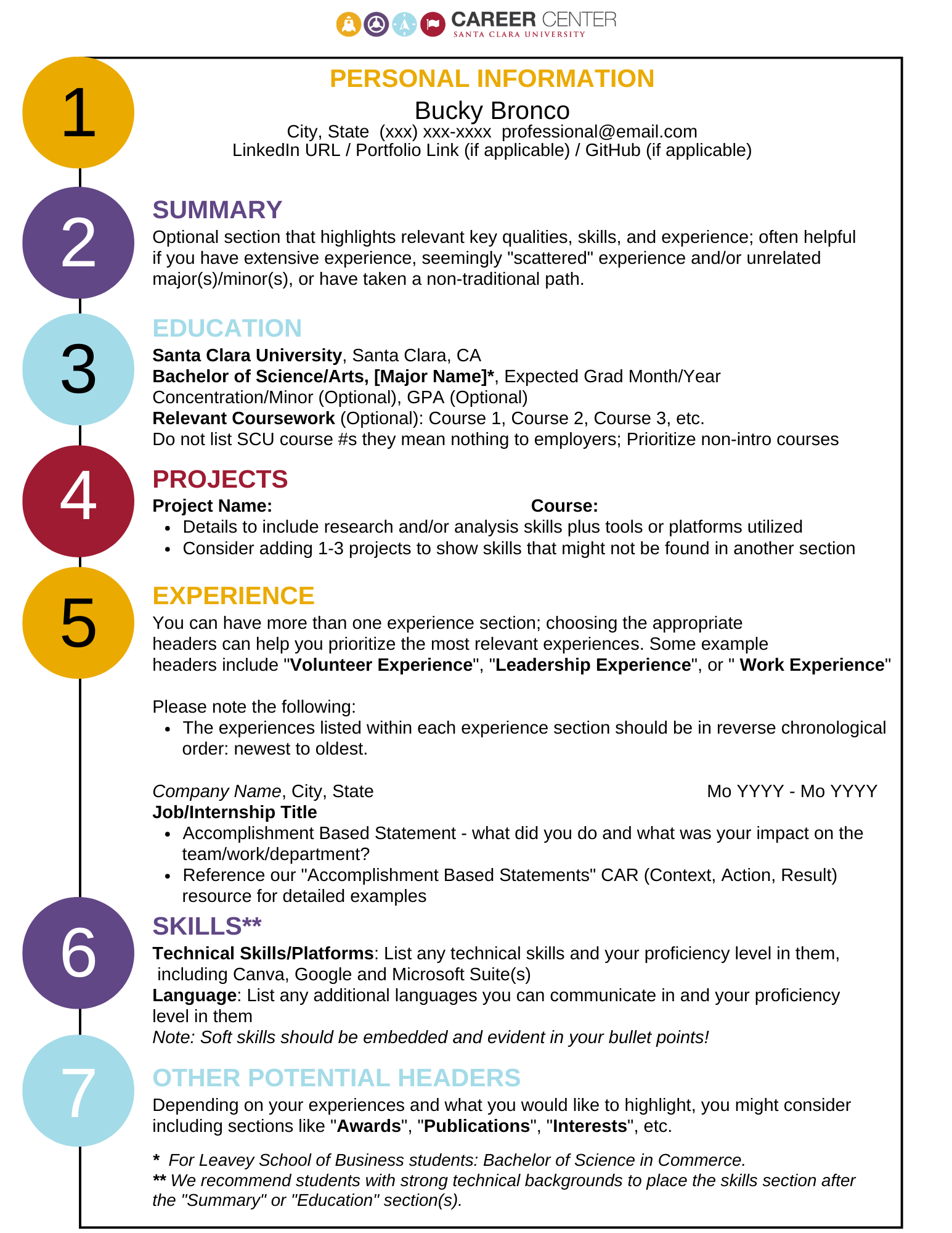Resumes
What is a resume?
A resume is a brief and well organized document primarily used for internship and job applications. The goal of a well-written resume is to help you secure an interview and typically includes your education, as well as relevant qualifications, experiences, and accomplishments. It should also be tailored/targeted to the industry and position for which you are applying. Consider the following next steps:
- Familiarize yourself with the anatomy of a resume
- Learn to craft impactful and effective bullet points (a.k.a. Accomplishment-based statements - this is where you will likely spend most of your time
- Utilize our A.I. resume tools to get started and/or receive instant feedback on an existing version of your resume
- Check out resume samples based on major/industry clusters
Anatomy of a resume

Quick tips:
- Create a “master resume” that includes all of your experiences so you can curate your one-pager(s) without having to write, delete, and rewrite each time .
- Consider “experiences” holistically (e.g. research, class projects, volunteer, athletics, leadership experience), not just formal internship roles or paid positions.
- Mirror the language you see in the internship/job description onto your resume.
- Consider including experiences that demonstrate top skills identified by the National Association of Colleges and Employers (NACE).
- Prioritize the most relevant experiences in the top half of your resume.
- Consider the skill behind the task and connect that to what a recruiter/hiring manager is looking for (e.g. skilled in latte art - is it creativity, resourcefulness, and/or persistence behind the ability to create latte art?).
- Quantify your bullet points when possible - this is a concrete way to demonstrate impact
- Use AI Resume Tools to help with tailor your resume for each job description and highlight key qualifications
Frequently asked questions:
For undergraduates, graduates, and new grads: one (most common) to two pages (max). Having trouble fitting everything into your resume? Get tips below, use an AI Resume Tool and/or schedule a resume review!
Photo(s) of yourself, personal information such as immigration status, political and/or religious affiliation, and marital status. Learn more here
Don’t underestimate the value of your educational experiences and/or other involvement. Identify skills that you developed through those experiences that are transferable to the roles you’re interested in. Consider including sections like: Relevant Coursework, Projects/Lab Experience, Honors/Awards, and Senior Thesis/Design. Do you babysit? Walk pets? Work at Starbucks? Help neighbors fix their appliances? Great! You can frame these experiences in a way that surfaces your skills in time management, resourcefulness, being a quick learner, etc.!
In general, you should focus on your college experiences. High school information may be included for first or second years who might not have a lot of college activities or work experiences yet. Consider listing your high school if you are tapping into an alumnus from that high school or job searching in your hometown area.
- Possible ways to reduce the length include: reformatting, reducing margins to 0.5 all around, eliminating less relevant experiences, and consolidating accomplishments that are mentioned repeatedly across multiple positions.
- Possible ways to increase the length: see above.
DO:
- Use Google Docs and/or Microsoft Word
- Keep it simple
Do NOT:
- Use tables/columns
- Use design platforms, such as Canva, to build your resume(s)
- *** The Applicant Tracking System (ATS) tends to not read resumes built in Canva or with tables/columns accurately.
Yes, but not for every individual job. Instead, have tailored resumes for different types of jobs. For example, if you are applying to software engineering and program management roles, you should have a different version of your resume for each.
- An ATS is a piece of software and tool that many companies use to organize and filter candidate applications, thus optimizing their recruitment process. When you upload a resume as part of an online application, an ATS system will scan your resume into an applicant database. It will scan your resume for keywords and phrases, which helps recruiters identify which applicants to focus on. Read more about how to customize your resume for ATS systems.
The most noticeable difference between a CV and a resume is the length. A resume is usually 1-2 pages, and a CV is often 3 or more pages. In the U.S. a resume is more common than a CV. A CV, often used in academia and internationally, is meant to provide a detailed, usually chronologically ordered, list of all of your achievements both academically and professionally. Common sections include research, publications, scholarly presentations, affiliations with professional associations, awards, etc. Applying to opportunities outside of the U.S.? Learn what different countries accept/prefer on GoinGlobal
Sample resumes
Feel free to reference the following resume samples and tailor yours accordingly. Remember to make a copy of the guide before editing/adding notes. These are all “view only” documents.
Undergraduate
- Bucky Bronco Resume
- Accounting
- Biology
- Business
- Communications
- Engineering
- Humanities
- Music
- Studio Art
- Theatre
- Athletics
- First Year Bronco
- Study Abroad
Graduate